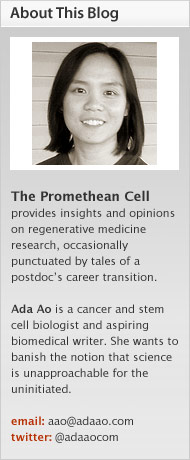« Prev Next »
I've flippantly used Mystique as my metaphor for explaining stem cells. I've also been promising some serious stem cell biology that I've found hard to adapt to the Mystique angle, mainly because of the rigidity of that reference. So, here's my penance and I'll introduce a more simple and elegant metaphor to explain cell differentiation, de-differentiation, and trans-differentiation.
Waddington's Landscape gave me with a delicious moment of perfect understanding when I was a graduate student. I still haven't forgotten that feeling. As a testament to the metaphor's impact and endurance, it has adapted and reincarnated over the years to accommodate new theories1, and I often turn to it as a reference point when considering new reports and discoveries. I hope you will find this metaphor just as useful.
Conrad Hal Waddington introduced his concept2 in 1957 to summarize his meditations on the tenets of developmental biology and how genes guide development. I should point out that Waddington was working in the pre-DNA age but had the insight to recognize the limits of individual genes. His key contribution is noting the dynamics of gene expression regulation and ushering in the concept of epigenetics (more on this later, I promise). He took a systemic (I sometimes think humanistic) view of developmental genetics and understood that each gene is like an instrument in an orchestra, development is like a harmonious symphony, and each instrument must be played in a coordinated manner to produce the intended sounds.
He applied the same reasoning in his Landscape. It describes a ball, representing a stem cell, rolling down a hill marked by uneven slopes and valleys. In this metaphor, the hill represents the cell differentiation process and genes shape the features on that hill. All those slopes and valleys ultimately channel the ball towards a favored position at the bottom of the hill. 
This beguilingly simple model pretty much summed up all of developmental biology for me. Everything I've learned since was built upon that foundation. Current theories on iPSCs and the complications associated with them, which I've harped about in previous posts, revolve around what is needed to shove a somatic cell/ball up the hill (de-differentiation), how some of the hills features may be smoothed over or leveled out (removing genetic barriers), and what might happen if the shoving stops partway up the hill (re-differentiation). I can keep going on about how the hill may be different for each person, etc...but I think you get the point.
Trans-differentiation follows a similar logic, but with a twist. Trans-differentiation is the conversion of one mature cell type to another, such as from skin to liver. You can imagine this as a ball being pushed in a direction parallel to the bottom of the hill to another location. This is different from iPSC reprogramming because that would require the ball to be pushed up the hill first (de-differentiate) before allowing it to roll back down the hill again - with some nudging along the way to turn it onto a different path. Many claims for trans-differentiation were largely based on the lack of evidence for de-differentiation, which is suppose to prove it was a direct conversion without a de-differentiated intermediate. At this point, it's not convincing evidence. A simple explanation can be the de-differentiation state was so unstable that it was undetectable. But if there's no de-differentiation ... does it mean the slopes and valleys that must be transversed constitute another axis of that hill, a dimension that's not "up" or "down" but "over"?
Nobody knows the answer to this yet, and it's arguable if it's biologically important or practical to study intermediate states. But people have said the same thing about pluripotent states, and what was considered to be mere semantics is now taken seriously. It makes sense to consider it if the goal is to have a pure population of replacement cells for clinical use because it's downright dangerous to have uncommitted strays around. So I think it's important to identify and study those intermediate states, if only so they can be removed or be fully converted before putting them in patients.
Image credits: © vtpeacenik-via Flickr (http://www.flickr.com/photos/63348497@N00/2425220246/)
- Yamanaka, S. Elite and stochastic models for induced pluripotent stem cell generation. Nature 460, 49-52 (2009).
- Waddington, CH. The Strategy of the Genes. A Discussion of Some Aspects of Theoretical Biology (Alen & Unwin, 1957).






















